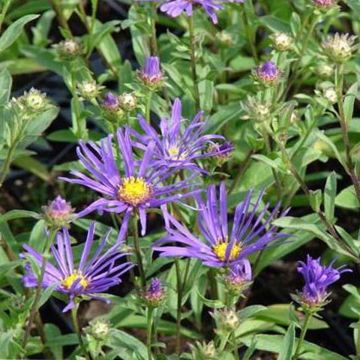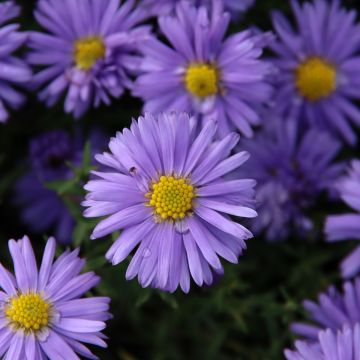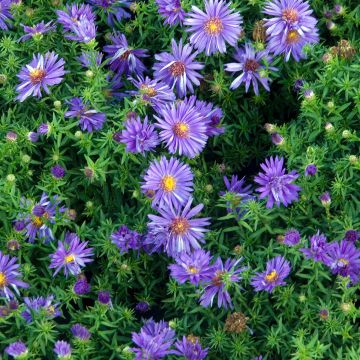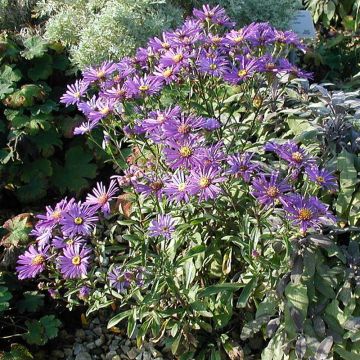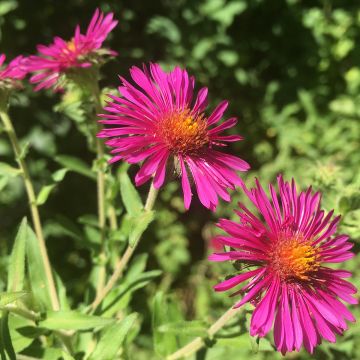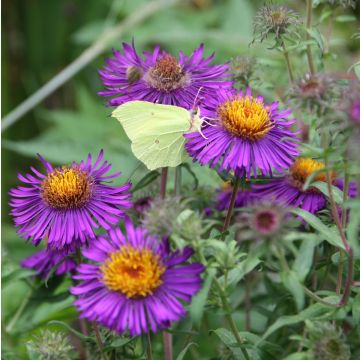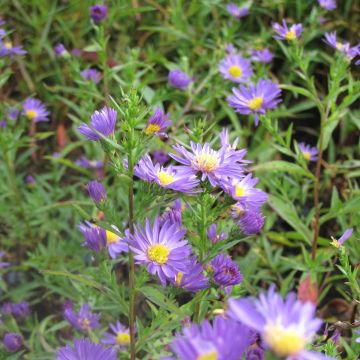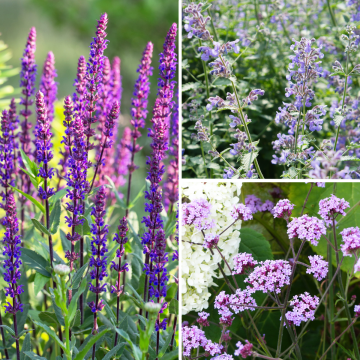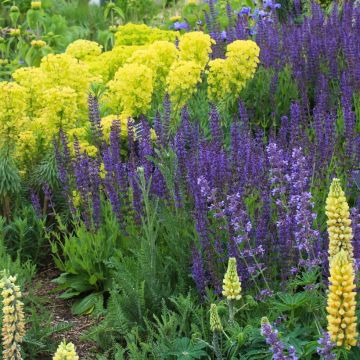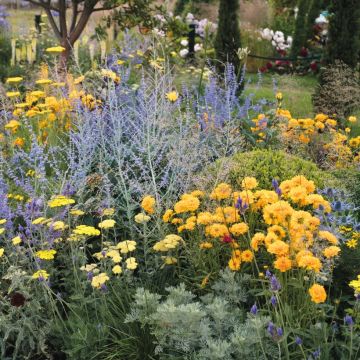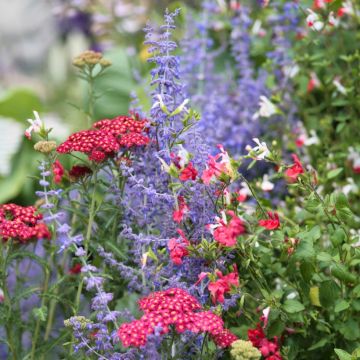

Collection of 3 New England asters - Grand Autumn Asters
Collection of 3 New England asters - Grand Autumn Asters
Aster novae-angliae Rosa Sieger Purple Dome, Andenken an Alma Pötschke
Grad Autumn Aster
Finally, some beautiful bushes. Matching colors. Everything grew well, even the one that seemed dead upon arrival (no green). All the plants were first potted to help them recover.
Dani, 12/09/2025
Special offer!
Receive a €20 voucher for any order over €90 (excluding delivery costs, credit notes, and plastic-free options)!
1- Add your favorite plants to your cart.
2- Once you have reached €90, confirm your order (you can even choose the delivery date!).
3- As soon as your order is shipped, you will receive an email containing your voucher code, valid for 3 months (90 days).
Your voucher is unique and can only be used once, for any order with a minimum value of €20, excluding delivery costs.
Can be combined with other current offers, non-divisible and non-refundable.
Home or relay delivery (depending on size and destination)
Schedule delivery date,
and select date in basket
This plant carries a 12 months recovery warranty
More information
We guarantee the quality of our plants for a full growing cycle, and will replace at our expense any plant that fails to recover under normal climatic and planting conditions.

Would this plant suit my garden?
Set up your Plantfit profile →
Description
This Collection of 3 New England asters offers a colourful, abundant and prolonged flowering during several weeks at the end of the season. In large flower beds, these tall perennials allow you to compose a magnificent autumn symphony in pink, purple and red. The New England asters are quite resistant to powdery mildew and they thrive in humid climates and heavy, clayey and fertile soils. They also offer better performance in flower beds than the New Belgium asters.
The collection consists of:
- 1 New England Aster 'Rosa Sieger', which is distinguished by the power of its flowering and the delicacy of its pink colour. From late summer to the first frost, this very beautiful plant is covered with bouquets of small daisies that range from fresh pink to very pale pink. This medium-sized variety measures between 90 cm (35in) and 1.20 m (4ft) in height when in flower.
- 1 New England Aster 'Purple Dome' with bright purple-violet flowers. Unlike other New England Asters, this one is quite compact, it won't exceed 50 cm (20in) in height and width. It should preferably be placed in front of the other tall asters.
- 1 New England Aster 'Andenken an Alma Pötschke' with raspberry-red flowers. It is one of the best varieties among the reds and its offspring is numerous. It is a tall aster that can reach a height of 1.50 m (5ft) when in flower.
Labeled separately
These beautiful asters are planted at the back of flower beds to extend the flowering season in the garden until autumn, but you can also plant them in large pots to brighten up the surroundings of your house. In the ground, create a country atmosphere around your asters with tall perennials (Gauras, Rudbeckia, perennial sunflowers, inulas) and small bushes (landscape roses, shrubby salvias), or even grasses such as Miscanthus or tufted hair grasses that appreciate the same growing conditions.
Report an error about the product description
Flowering
Foliage
Plant habit
Botanical data
Aster
novae-angliae
Rosa Sieger Purple Dome, Andenken an Alma Pötschke
Asteraceae
Grad Autumn Aster
Cultivar or hybrid
Other Asters
View all →Planting and care
Plant the young plant New England Asters in autumn or spring in ordinary, rich and well-worked soil, keeping it moist. It can withstand temperatures as low as -30 °C (1°F). It prefers a sunny exposure, but can tolerate partial shade where it will have a slightly looser habit. It is necessary to avoid strong winds that would flatten the clumps. It may be useful to stake the stems in certain cases. Once established, it should not be moved, as it does not appreciate changes. In a flower bed, leave at least 50 cm (20in) spacing between the plants. This plant does not tolerate competition from other roots at all. Mulch the soil from June onwards and water in case of heatwaves. New England Asters are not susceptible to powdery mildew. Divide the clumps every three years to keep them flowering well. Do not replant the divisions in the same place and give them a rich soil.
Planting period
Intended location
Care
-
, onOrder confirmed
Reply from on Promesse de fleurs
Similar products
Haven't found what you were looking for?
Hardiness is the lowest winter temperature a plant can endure without suffering serious damage or even dying. However, hardiness is affected by location (a sheltered area, such as a patio), protection (winter cover) and soil type (hardiness is improved by well-drained soil).

Photo Sharing Terms & Conditions
In order to encourage gardeners to interact and share their experiences, Promesse de fleurs offers various media enabling content to be uploaded onto its Site - in particular via the ‘Photo sharing’ module.
The User agrees to refrain from:
- Posting any content that is illegal, prejudicial, insulting, racist, inciteful to hatred, revisionist, contrary to public decency, that infringes on privacy or on the privacy rights of third parties, in particular the publicity rights of persons and goods, intellectual property rights, or the right to privacy.
- Submitting content on behalf of a third party;
- Impersonate the identity of a third party and/or publish any personal information about a third party;
In general, the User undertakes to refrain from any unethical behaviour.
All Content (in particular text, comments, files, images, photos, videos, creative works, etc.), which may be subject to property or intellectual property rights, image or other private rights, shall remain the property of the User, subject to the limited rights granted by the terms of the licence granted by Promesse de fleurs as stated below. Users are at liberty to publish or not to publish such Content on the Site, notably via the ‘Photo Sharing’ facility, and accept that this Content shall be made public and freely accessible, notably on the Internet.
Users further acknowledge, undertake to have ,and guarantee that they hold all necessary rights and permissions to publish such material on the Site, in particular with regard to the legislation in force pertaining to any privacy, property, intellectual property, image, or contractual rights, or rights of any other nature. By publishing such Content on the Site, Users acknowledge accepting full liability as publishers of the Content within the meaning of the law, and grant Promesse de fleurs, free of charge, an inclusive, worldwide licence for the said Content for the entire duration of its publication, including all reproduction, representation, up/downloading, displaying, performing, transmission, and storage rights.
Users also grant permission for their name to be linked to the Content and accept that this link may not always be made available.
By engaging in posting material, Users consent to their Content becoming automatically accessible on the Internet, in particular on other sites and/or blogs and/or web pages of the Promesse de fleurs site, including in particular social pages and the Promesse de fleurs catalogue.
Users may secure the removal of entrusted content free of charge by issuing a simple request via our contact form.
The flowering period indicated on our website applies to countries and regions located in USDA zone 8 (France, the United Kingdom, Ireland, the Netherlands, etc.)
It will vary according to where you live:
- In zones 9 to 10 (Italy, Spain, Greece, etc.), flowering will occur about 2 to 4 weeks earlier.
- In zones 6 to 7 (Germany, Poland, Slovenia, and lower mountainous regions), flowering will be delayed by 2 to 3 weeks.
- In zone 5 (Central Europe, Scandinavia), blooming will be delayed by 3 to 5 weeks.
In temperate climates, pruning of spring-flowering shrubs (forsythia, spireas, etc.) should be done just after flowering.
Pruning of summer-flowering shrubs (Indian Lilac, Perovskia, etc.) can be done in winter or spring.
In cold regions as well as with frost-sensitive plants, avoid pruning too early when severe frosts may still occur.
The planting period indicated on our website applies to countries and regions located in USDA zone 8 (France, United Kingdom, Ireland, Netherlands).
It will vary according to where you live:
- In Mediterranean zones (Marseille, Madrid, Milan, etc.), autumn and winter are the best planting periods.
- In continental zones (Strasbourg, Munich, Vienna, etc.), delay planting by 2 to 3 weeks in spring and bring it forward by 2 to 4 weeks in autumn.
- In mountainous regions (the Alps, Pyrenees, Carpathians, etc.), it is best to plant in late spring (May-June) or late summer (August-September).
The harvesting period indicated on our website applies to countries and regions in USDA zone 8 (France, England, Ireland, the Netherlands).
In colder areas (Scandinavia, Poland, Austria...) fruit and vegetable harvests are likely to be delayed by 3-4 weeks.
In warmer areas (Italy, Spain, Greece, etc.), harvesting will probably take place earlier, depending on weather conditions.
The sowing periods indicated on our website apply to countries and regions within USDA Zone 8 (France, UK, Ireland, Netherlands).
In colder areas (Scandinavia, Poland, Austria...), delay any outdoor sowing by 3-4 weeks, or sow under glass.
In warmer climes (Italy, Spain, Greece, etc.), bring outdoor sowing forward by a few weeks.































